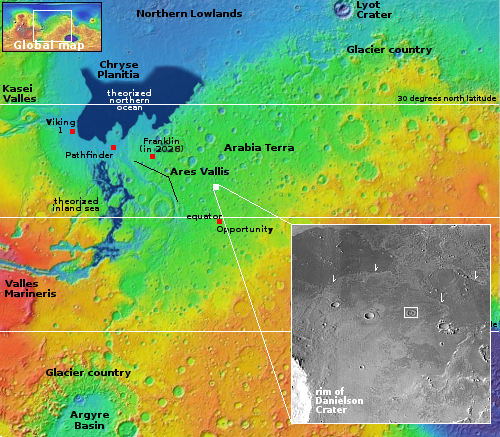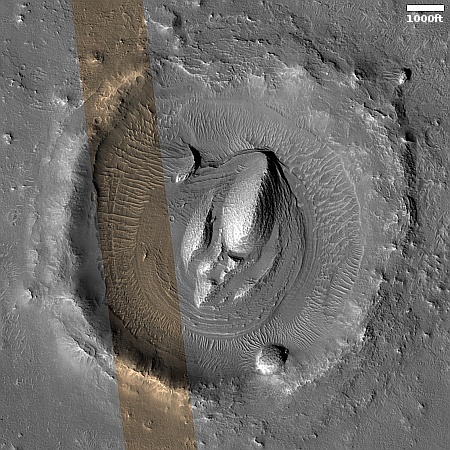Layered Martian mesa inside crater
Cool image time! The picture to the right, cropped, reduced, and enhanced to post here, was taken on May 14, 2024 by the high resolution camera on Mars Reconnaissance Orbiter (MRO). It shows what the scientists label as a “layered butte inside small crater.”
The crater is only about 1.8 miles across, and is only a couple of hundred feet deep, at the most. Because this crater sits on a large slope rising to the southwest, the mesa’s peak is actually about thirty feet higher than the crater’s northern rim, but is still below the southern rim by about 70 feet.
A close look at the mesa’s slopes suggests about a dozen obvious layers, though based on data from the rovers Curiosity and Perseverance, those obvious layers are probably divided into many hundreds of thinner layers in between.
What caused these layers? And how did such a small crater get such a relatively large mesa in its center? As always, the overview map provides some clues, but as always it does not provide a definitive answer.

The white dot on the overview map to the right marks the location, in the middle of Arabia Terra, the largest transistion zone on Mars between its northern lowland plains and its southern cratered highlands. The crater sits about 400 miles due north of the region explored by the rover Opportunity, inside the Martian dry tropics.
The inset provides some hints as to what is happening here. The crater sits about 24 miles northeast from the rim of 41-mile-wide Danielson Crater, and appears to actually sit on the splash melt that flowed down from that crater after its impact. The small arrows indicate the front edges of that splash melt.
Of the other similar sized craters in the inset, this is the only crater with a mesa in the middle. The others look like ordinary impact craters that occurred long after the Danielson impact, or were secondary ejecta hits at the time of the Danielson impact.
So why does this crater have this mesa? I have no idea, nor do I have any theories that make sense. My first guess was that the crater was a caldera from which that splash melt had flowed, but the topography and shape of the crater does not support that theory. Nor does mesa or its layers.
On Christmas Eve 1968 three Americans became the first humans to visit another world. What they did to celebrate was unexpected and profound, and will be remembered throughout all human history. Genesis: the Story of Apollo 8, Robert Zimmerman's classic history of humanity's first journey to another world, tells that story, and it is now available as both an ebook and an audiobook, both with a foreword by Valerie Anders and a new introduction by Robert Zimmerman.
The print edition can be purchased at Amazon or from any other book seller. If you want an autographed copy the price is $60 for the hardback and $45 for the paperback, plus $8 shipping for each. Go here for purchasing details. The ebook is available everywhere for $5.99 (before discount) at amazon, or direct from my ebook publisher, ebookit. If you buy it from ebookit you don't support the big tech companies and the author gets a bigger cut much sooner.
The audiobook is also available at all these vendors, and is also free with a 30-day trial membership to Audible.
"Not simply about one mission, [Genesis] is also the history of America's quest for the moon... Zimmerman has done a masterful job of tying disparate events together into a solid account of one of America's greatest human triumphs."--San Antonio Express-News
Cool image time! The picture to the right, cropped, reduced, and enhanced to post here, was taken on May 14, 2024 by the high resolution camera on Mars Reconnaissance Orbiter (MRO). It shows what the scientists label as a “layered butte inside small crater.”
The crater is only about 1.8 miles across, and is only a couple of hundred feet deep, at the most. Because this crater sits on a large slope rising to the southwest, the mesa’s peak is actually about thirty feet higher than the crater’s northern rim, but is still below the southern rim by about 70 feet.
A close look at the mesa’s slopes suggests about a dozen obvious layers, though based on data from the rovers Curiosity and Perseverance, those obvious layers are probably divided into many hundreds of thinner layers in between.
What caused these layers? And how did such a small crater get such a relatively large mesa in its center? As always, the overview map provides some clues, but as always it does not provide a definitive answer.

The white dot on the overview map to the right marks the location, in the middle of Arabia Terra, the largest transistion zone on Mars between its northern lowland plains and its southern cratered highlands. The crater sits about 400 miles due north of the region explored by the rover Opportunity, inside the Martian dry tropics.
The inset provides some hints as to what is happening here. The crater sits about 24 miles northeast from the rim of 41-mile-wide Danielson Crater, and appears to actually sit on the splash melt that flowed down from that crater after its impact. The small arrows indicate the front edges of that splash melt.
Of the other similar sized craters in the inset, this is the only crater with a mesa in the middle. The others look like ordinary impact craters that occurred long after the Danielson impact, or were secondary ejecta hits at the time of the Danielson impact.
So why does this crater have this mesa? I have no idea, nor do I have any theories that make sense. My first guess was that the crater was a caldera from which that splash melt had flowed, but the topography and shape of the crater does not support that theory. Nor does mesa or its layers.
On Christmas Eve 1968 three Americans became the first humans to visit another world. What they did to celebrate was unexpected and profound, and will be remembered throughout all human history. Genesis: the Story of Apollo 8, Robert Zimmerman's classic history of humanity's first journey to another world, tells that story, and it is now available as both an ebook and an audiobook, both with a foreword by Valerie Anders and a new introduction by Robert Zimmerman.
The print edition can be purchased at Amazon or from any other book seller. If you want an autographed copy the price is $60 for the hardback and $45 for the paperback, plus $8 shipping for each. Go here for purchasing details. The ebook is available everywhere for $5.99 (before discount) at amazon, or direct from my ebook publisher, ebookit. If you buy it from ebookit you don't support the big tech companies and the author gets a bigger cut much sooner.
The audiobook is also available at all these vendors, and is also free with a 30-day trial membership to Audible.
"Not simply about one mission, [Genesis] is also the history of America's quest for the moon... Zimmerman has done a masterful job of tying disparate events together into a solid account of one of America's greatest human triumphs."--San Antonio Express-News



As usual, the headline is more sensationalistic than the article itself. I am almost 50 years old and it has been that way as long as I remember.
Cloudy: Um, what headline are you referring to? I don’t think “Layered Martian mesa inside crater” is particular sensationalistic.